The non eco-garden is a companion blog to my earlier one, explaining and extolling the virtues of a garden that encourages wildlife and wild flowers. Eco or Wildlife gardens are also excellent for soil health, and have good wider ecological implications for the environment. This blog examines the flip side; things we may unintentionally do, which actively discourage nature. Without meaning to be judgemental, I’ll be referring to non-wildlife gardens as “bad gardens”. This is mainly to give a verbal shortcut, rather than me trying to be sanctimonious or preaching sustainability and ecological awareness!
The Illustration this blog is based on depicts a “bad garden” in Sweden, where FOR (the commissioning client) are based.
Hard surfaces
Bad gardens are full of hard surfaces. These can take the form of wooden decking, or lots of paving.
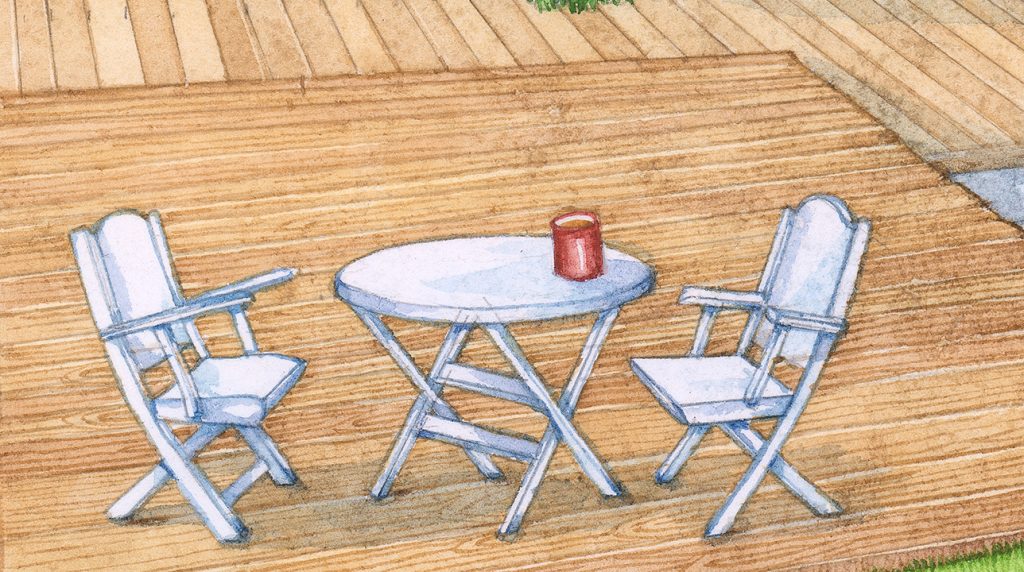
Wooden decking
Hard surfaces are detrimental in various ways. In hot climates, paving absorbs heat, and really speeds up the drying out of surrounding soils and turf. An area of soil covered with decking or paving slabs isn’t able to sustain any plants, nor the pollinators and other animals that rely on them.
There’s also the issue of flooding. Rainwater, which with climate change is increasingly unpredictable and can be torrential, simply runs off paved or decked gardens. This leads to soil erosion, and on a wider scale, contributes to flooding.
It’s also important to note that hard surfaces are pretty ubiquitous on a wider scale than just in our own gardens. Local government often opt for concrete or paved areas as they’re a little easier to care for. If possible, councils and those in charge on public spaces should be encouraged to take a more environmentally sound approach.
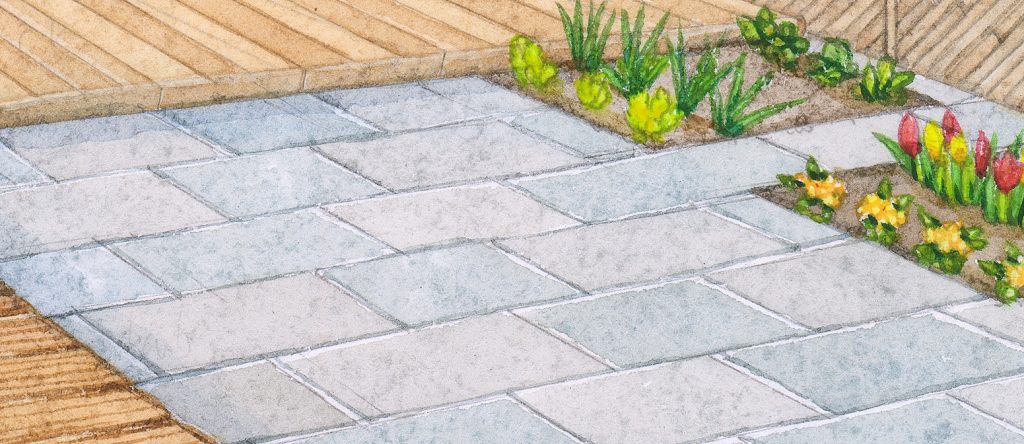
Paving
There’s also plenty of evidence that having a garden full of plants rather than timber and concrete, creates a healthier environment. Plants absorb pollutants, and produce oxygen. And, of course, they often look a great deal prettier than an area of hard standing. Hazel Dawe of the Oxfordshire Green Party discusses this in her letter to the Oxford Mail, concluding with, “This affliction can be avoided through a combination of action by property owners and perceptive support from local authorities and community groups to encourage planting.” I couldn’t agree more.
Lack of trees and shrubs
A bad garden will be devoid of trees and shrubs. Trees are important for a whole glut of wildlife. Insects feed on their leaves, and hide in the cracks and crannies of their bark. Birds use them for protection and nest sites, roost in them, and eat the insects feeding on tree foliage.

Long tailed tits Aegithalos caudatus
Mammals may hibernate in amongst the leaf litter that accumulates at the base of their trunks.
There’s also the wider issue of offsetting carbon dioxide. Trees (like all plants) absorb carbon dioxide and produce oxygen. Then help lock away the Co2 that’s contributing to the climate emergency.
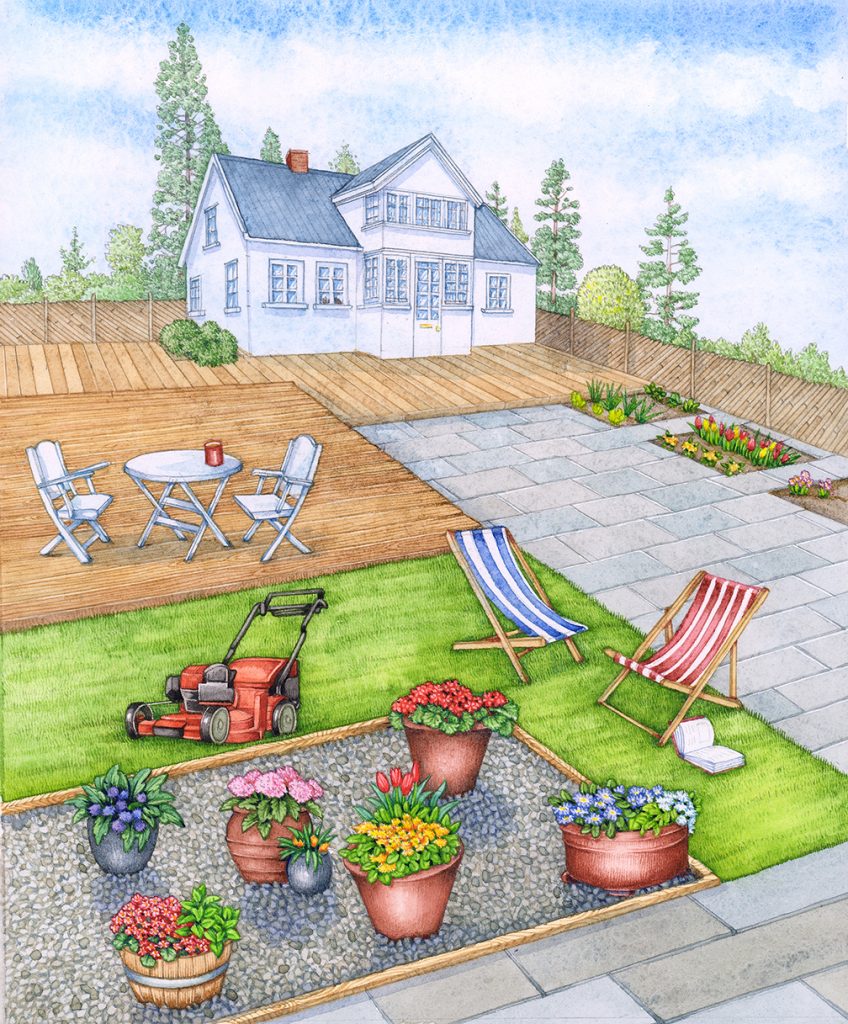
Garden without trees
Then there’s an argument for planting trees which doesn’t have any message attached. Trees are beautiful! They also provide shade in a garden, and many have gorgeous foliage, especially in autumn. For more on why to plant trees and shrubs, check out the Woodland Trust’s site.
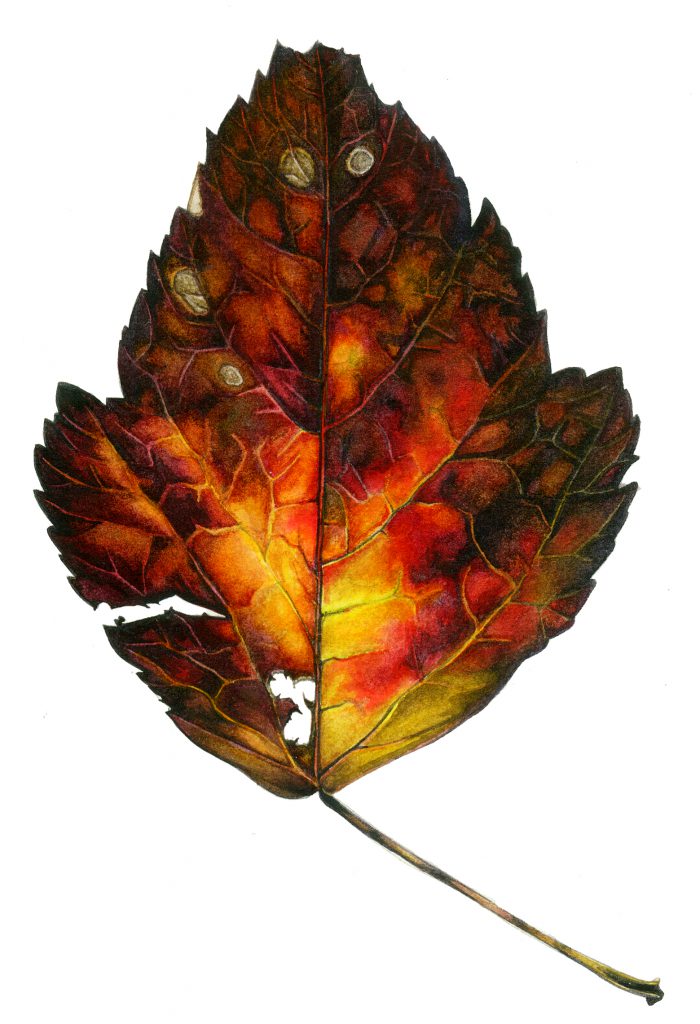
Acer autumn leaf
Fencing
Fencing encloses your space effectively. However, it provides nothing for wildlife or wild flowers. The other alternative, hedges, provide walls of protection, nutrients, and nesting spaces for wildlife. You can also choose any number of lovely hedging plants which give gorgeous flowers, scents, and leaf colour year round.
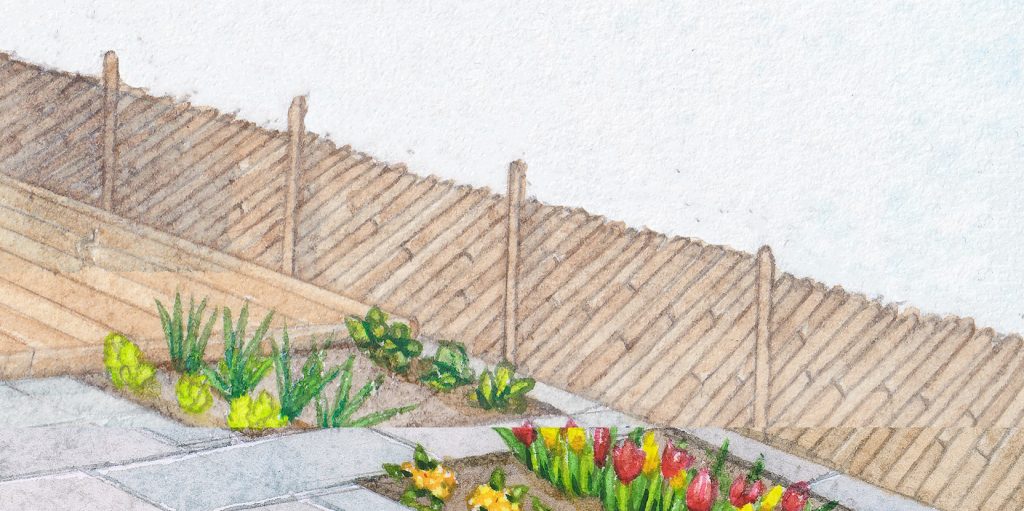
Fencing
Species such as Holly, Beech, Hazel, Hawthorn, Holm oak and Yew are popular for hedging in the UK. You could also choose a conifer hedge. Although better than a fence, Leylandii and Cypress hedging isn’t nearly as welcoming to wildlife as deciduous species. It does still filter out air pollution (Leylandii is the best of all UK hedging plants at this) but it’s a greedy plant, taking nutrients from the soil and not replacing them. Its’ evergreen leaves don’t fall and rot back into the earth. For more on the famous Leyalndii check out the Guardian newspaper’s article.
In Sweden, where the client who commissioned this “bad garden” illustration is based, common hedge plants include Chokeberry, Potentilla, and Lilac.
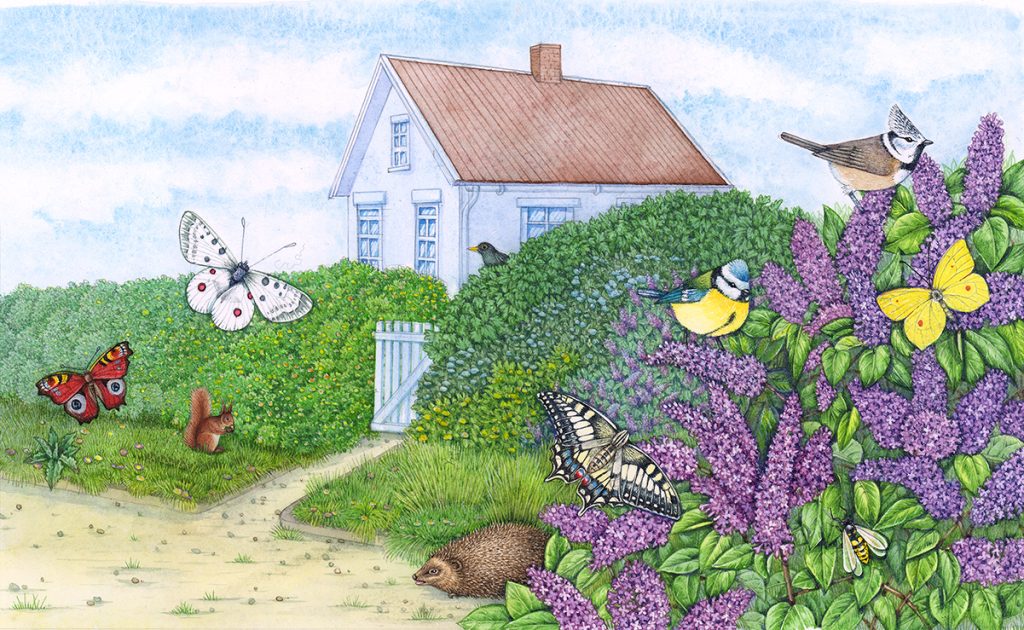
Swedish lilac hedge
Water use
Bad gardens will use hose pipes for all their watering needs, often leaving sprinklers going far longer than is required, and wasting good drinking water even at times of drought. Rainwater is also better for plant health than piped water from the mains. Fitting and using water butts and watering cans is a better (if slightly harder) option.
Areas of water like ponds or even bird baths can prove really important for visiting wildlife. Consider adding a pond to your garden.
Close mowing
A beautiful bowling-green lawn may look lovely. But it’s a desert for wildlife. No hiding places, no nectar-rich wildflowers, no moisture stores, no nutritious grass seeds to eat. In the UK there’s a big push to encourage people to mow their lawns less, called “No-mow May” and it’s got tangible positive effects for butterflies and other insects.
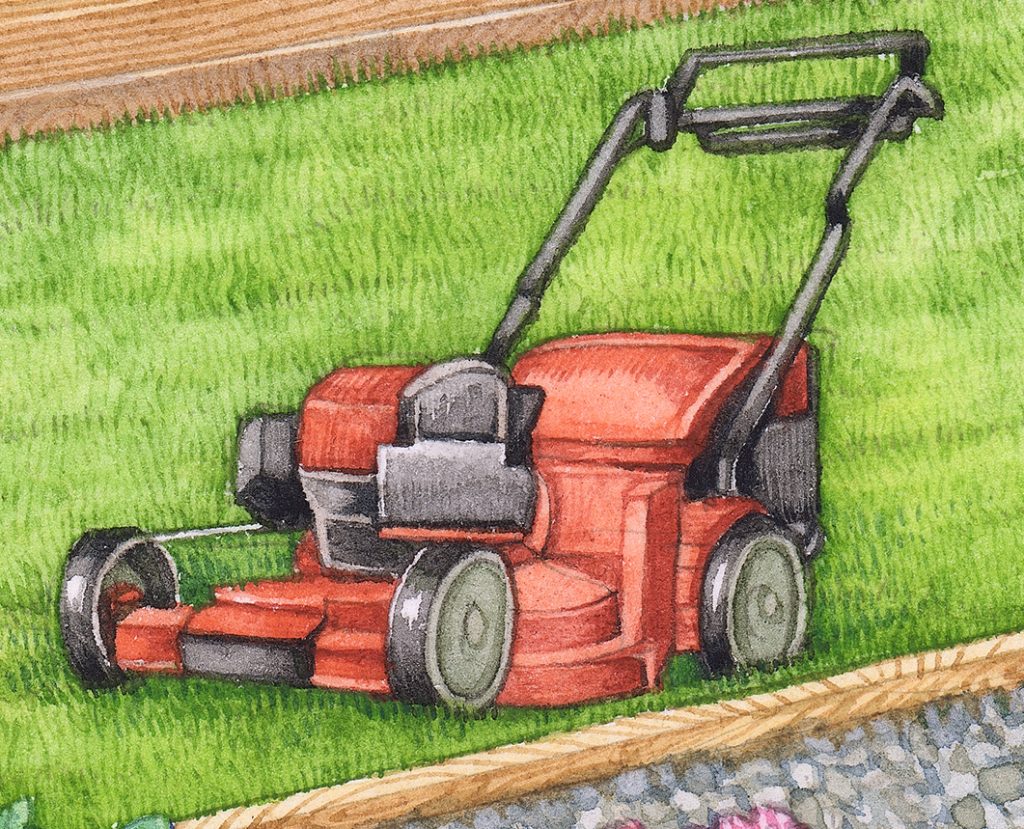
Mown grass
If you must mow often, maybe limit the area you crop so closely, and leave some areas of longer grass for the wildlife.
A good idea is to leave the grass cutting in situ on the lawn, to rot down and add nutrients back into the soil. You can also do this with fallen leaves, once dry. Just mow them and leave them to rot down over winter.
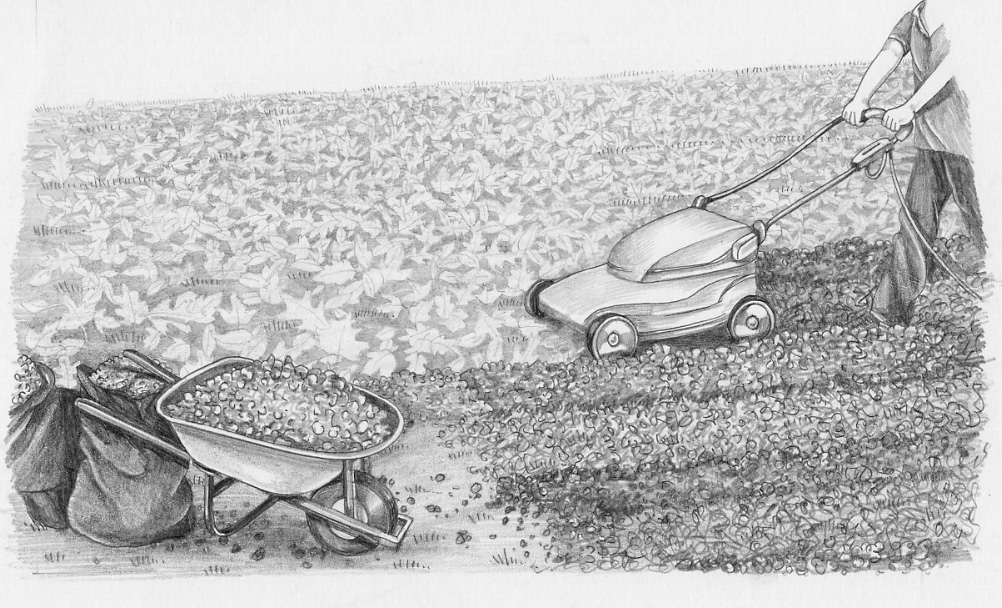
Mulching leaves by mowing them into the lawn
Some people like the idea of a lawn, but feel that the upkeep of grass is too much trouble, or that patches of mud resulting from vigorous children’s play are unsightly. They may choose to use plastic artificial lawns instead. I’m not even going to pretend not to be judgemental here. This is not only an appalling choice for wildlife, plant health, your plastic waste and eco-footprint; but it’s also darned ugly. Please, please, if at all possible, avoid making this choice. For an overview of why artificial lawns are so bad, check out this article from the University of Plymouth.
Pesticide and Herbicide use
In a non-eco friendly garden, you’ll find liberal use of pesticides and herbicides. These kill many species as well as the target pest, and can accumulate in the food-chain. Many of the plant species targeted by herbicides, such as the dandelion, are incredible sources of nectar and pollen for visiting insects.

Jersey Post Beetles Presentation Pack with Ladybird, House longhorn Hylotrupes bajulus and wasp beetle
There are other ways of discouraging pest plant and animal species. Research companion planting, and biological control of pest species. The latter include introducing nematode worms to deal with slugs, and ladybirds to control aphids.
Exposed Soil
Big patches of exposed soil aren’t a great idea, in general gardens are much healthier if there’s green cover over the substrate. This means the soil is always being re-energized with rotting down matter. Winter is a key time, when many vegetable plots will sit empty, soil exposed to the world. As the Guardian says, “Your soil cannot lie bare over the winter months. The wind, rain and cold will damage the precious top layer; it will lose nutrients and structure, and start to erode.”
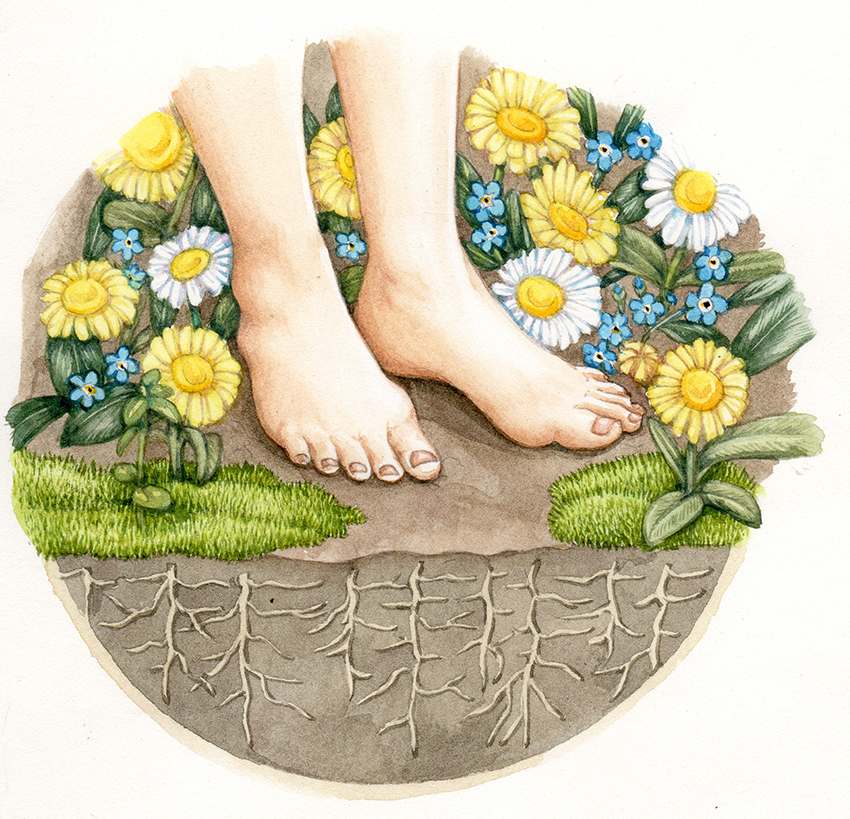
Bare feet on the soil with garden flowers behind, including marigold and forget me nots
Even in summer, make sure flower beds are allowed to grow weeds if it’s not planted with other things. After all, a weed is just a plant growing in the wrong place!
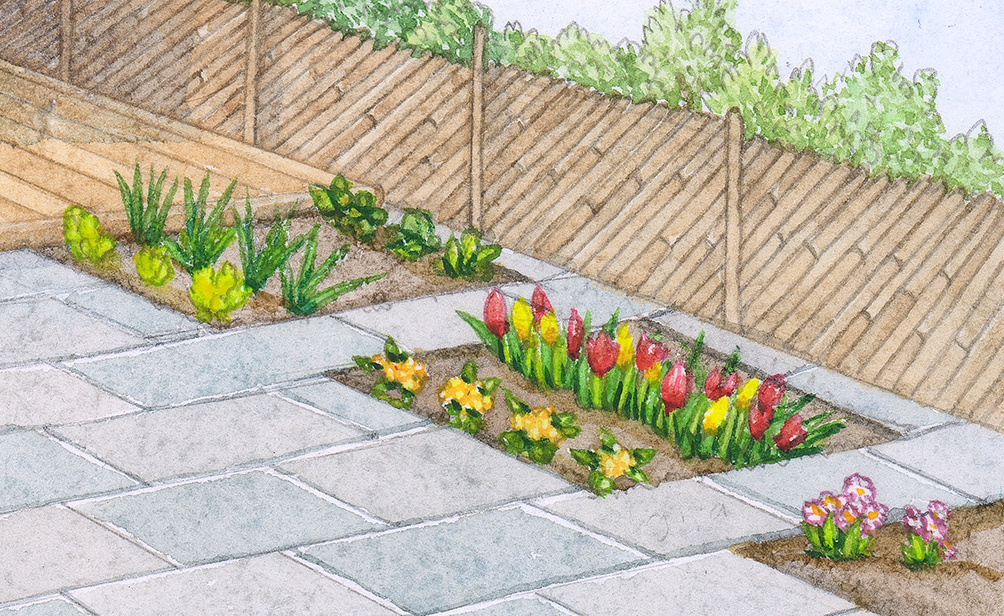
Flower beds with lots of exposed soil
While we’re talking about bare soil, it should be pointed out that some soil covers, such as wood chip, are fine for wildlife. But others, like broken slate or some gravel cover, can be yet another way to add to the hard surfaces in your garden. Saying that, gravel gardens, if planted carefully, can be great for wildlife, especially in Mediterranean or drought-prone areas. For more on this, look at the Wildlife Trusts article.
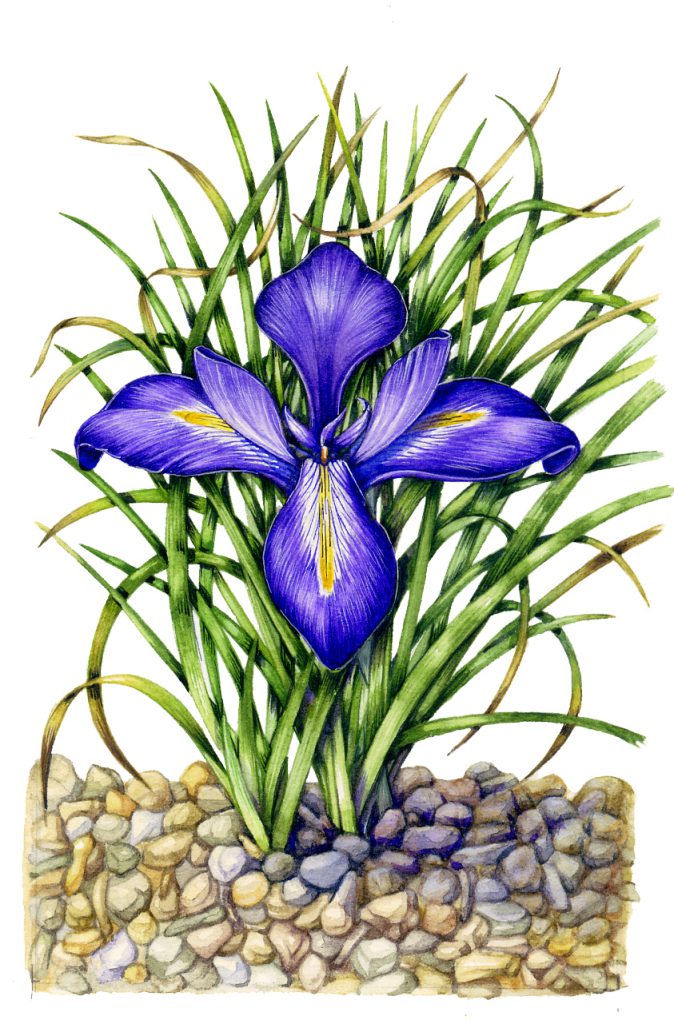
Iris reticulata growing in gravel
And what to do with the weeds when you DO want to remove them? Pull them up! The latest thinking is to just let them stay on the soil, acting as mulch.
Plant choice
I realise this is a little contentious as people know very well what they do and don’t wish to grow in their gardens. It goes without saying that some plants is better than having no plants. Even if your garden is very small, consider container gardening.
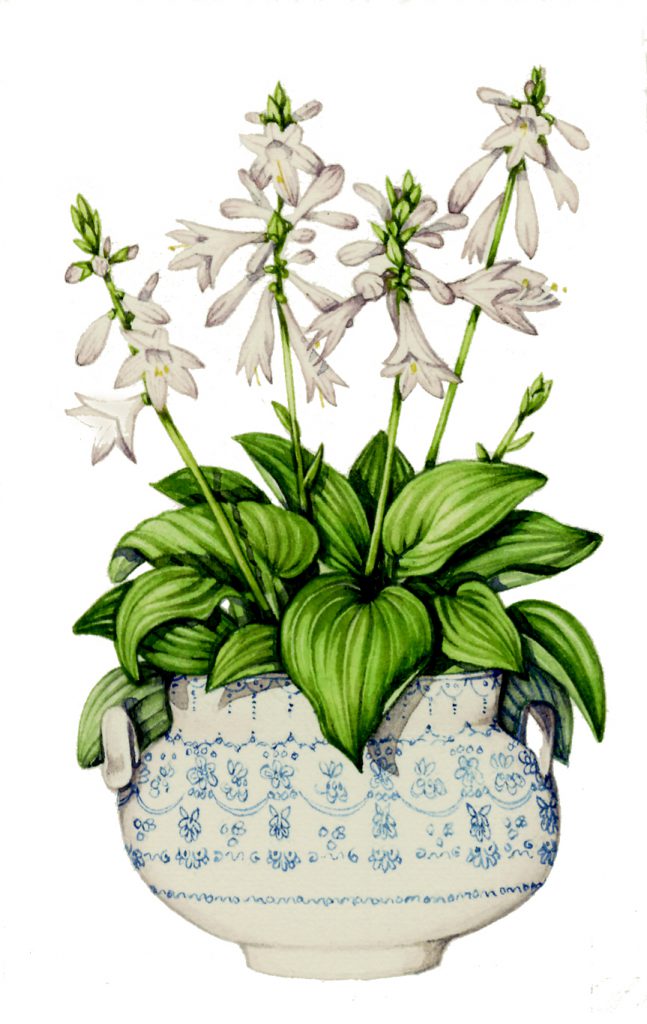
Hostas funkia in a pot
However, if you’re avoiding a bad garden, there are some suggestions. Generally, planting perennials is a better option than planting annuals.
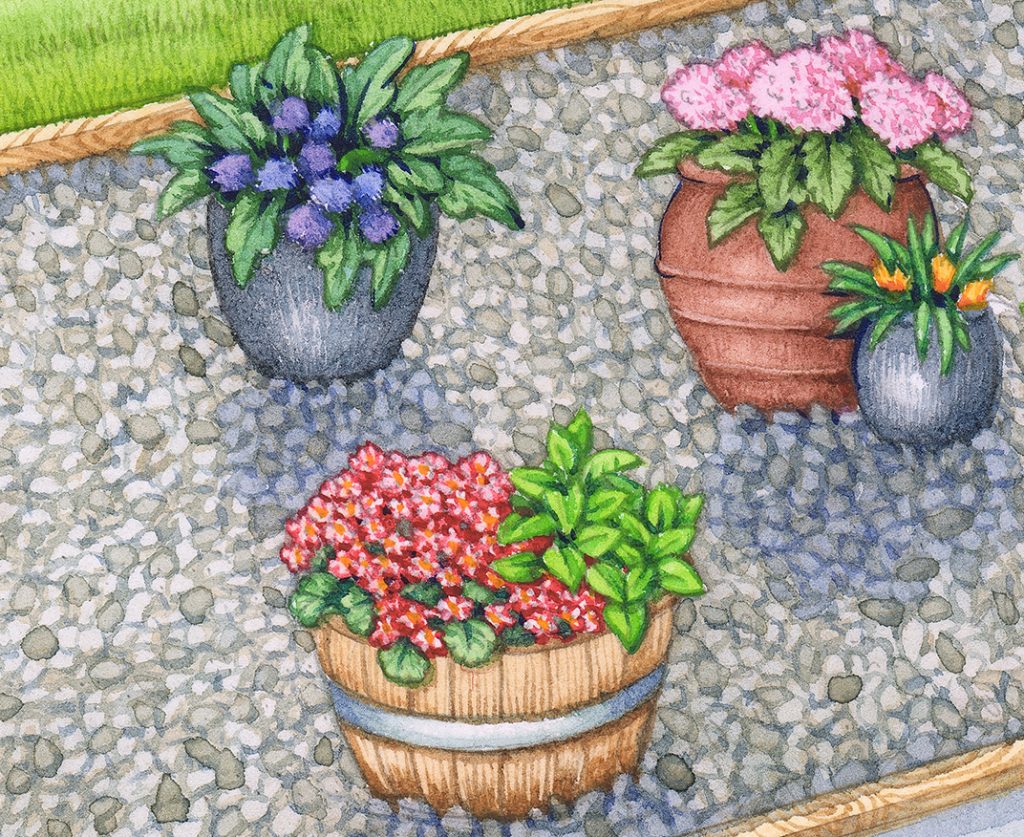
Non-native annuals in pots
This is partly because the remnants of perennials can be allowed to sit over winter, helping nature and the soil. It’s also because perennials are far less work for the gardener! For more on this look at the Sunday Gardener’s blog.
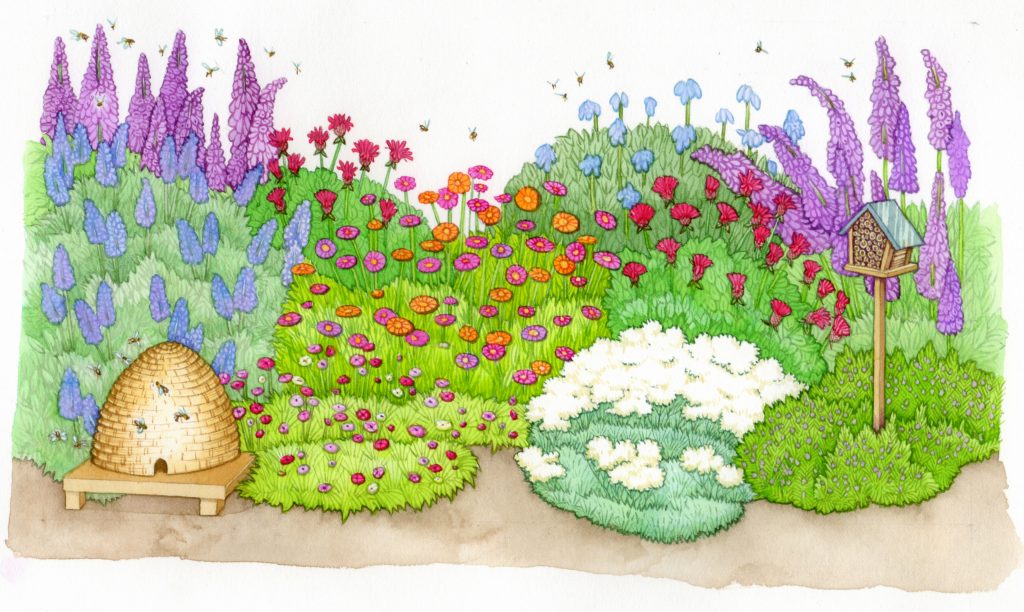
When choosing what species to plant, try to go for flowers which are known to encourage wildlife. Increasingly, these will be marked with a little motif of a bee or similar.
Many of our popular garden plants do nothing for wildlife. Many roses, chrysanthemums, tulips, annuals, and bedding plants offer nothing to pollinators. Some are even dangerous, either because they’ve been drenched in pesticides during their intensive growing phase, or because some plants can poison bees. These include Rhododendron, Mountain Laurel, and Carolina jessamine. For a fuller list, click here.
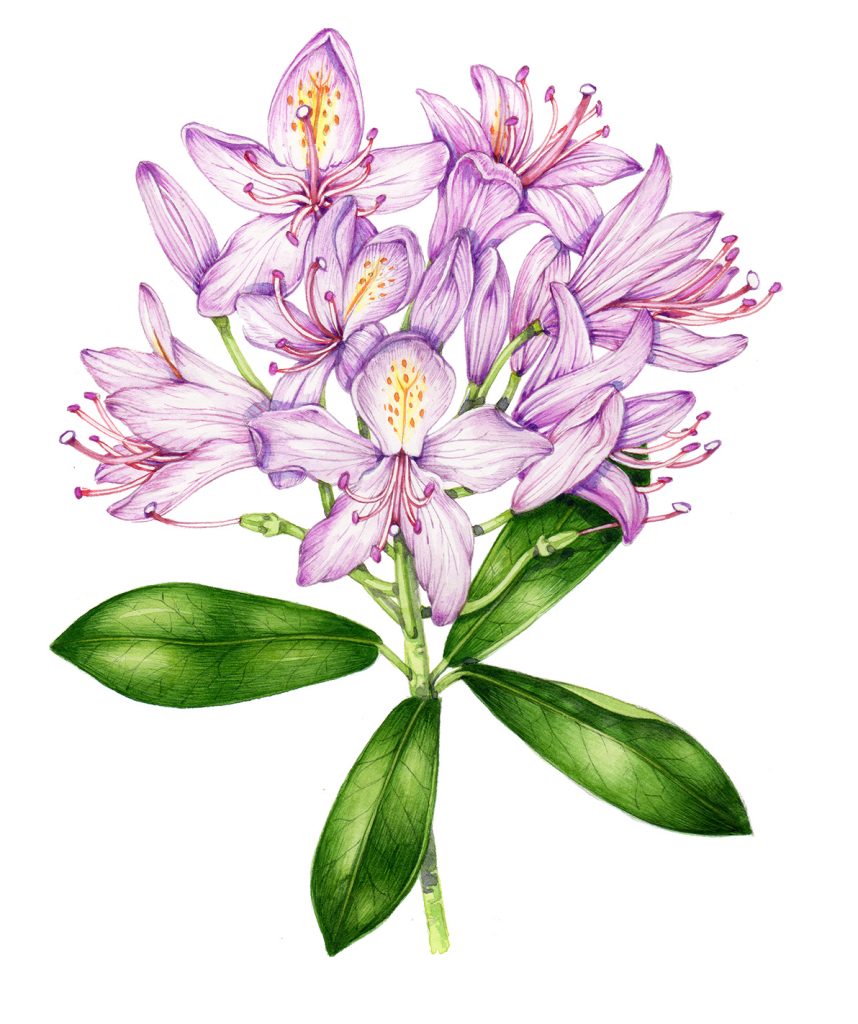
Rhododendron ponticum, very beautiful, but known to be poisonous to bees
A brilliant list of pollinator-friendly flowers to use for inspiration comes from the lab of one of my heroes, Dave Goulson.
You might also want to put native wildflowers in your garden. This will bring in a wider range of insects as they will have co-evolved with these plants. Some beauties include the Foxglove, Knapweed, Primrose, Yarrow, Snakes-head fritillary, Bugle, Honeysuckle, and Forget-me-not. For more, click here. Many appear early in the year.
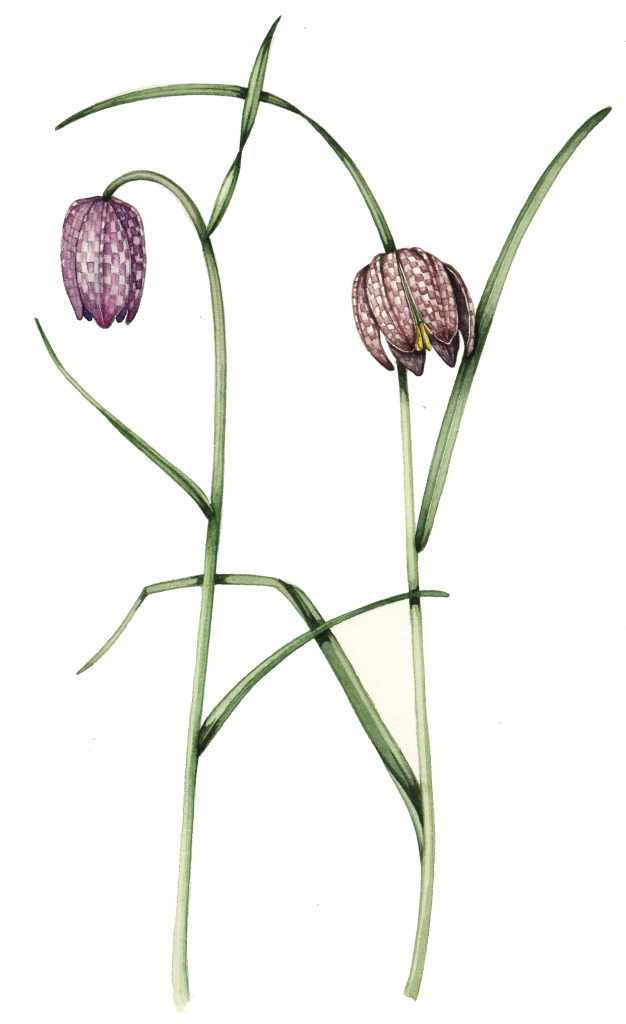
Snakeshead fritillary Fritillaria meleagris
Conclusion
Hopefully this blog will have given a few pointers on things to avoid if you want to garden in a way which is environmentally sound, and good for nature. For far more on this topic, and how to work towards a really good garden, please look at my blog on “good” garden .
The post The Bad Garden appeared first on Lizzie Harper.






